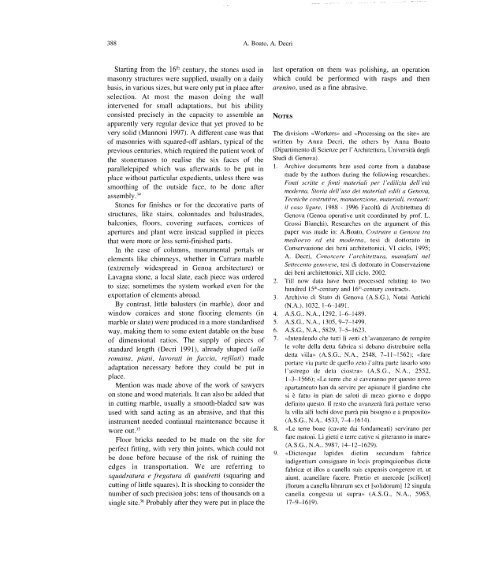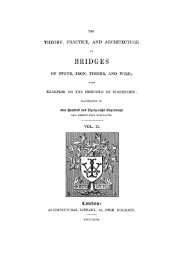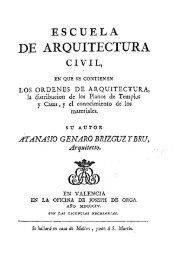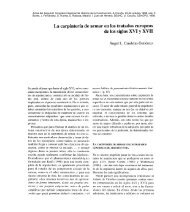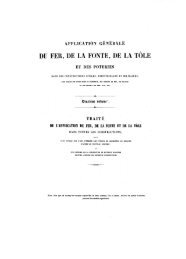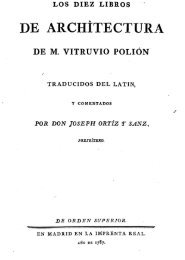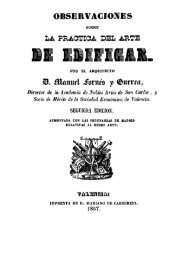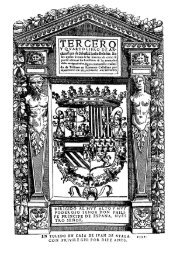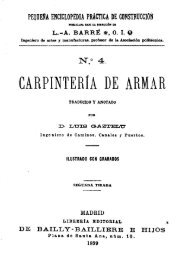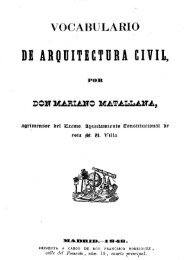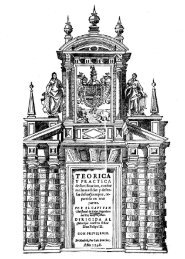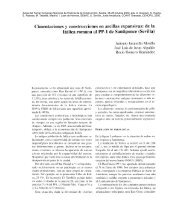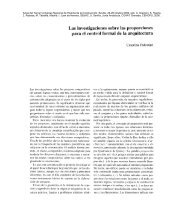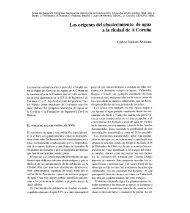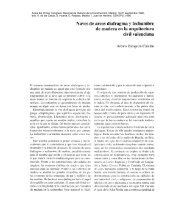Archive documents and building organisation. An example from the ...
Archive documents and building organisation. An example from the ...
Archive documents and building organisation. An example from the ...
You also want an ePaper? Increase the reach of your titles
YUMPU automatically turns print PDFs into web optimized ePapers that Google loves.
388 A. Boato, A. Decri<br />
Starting <strong>from</strong> <strong>the</strong> 16th century, <strong>the</strong> stones used in<br />
masonry structures were supplied, usually on a daily<br />
basis, in various sizes, but were only put in place after<br />
selection. At most <strong>the</strong> mason doing <strong>the</strong> wall<br />
intervened for smaJl adaptations, but his ability<br />
consisted precisely in <strong>the</strong> capacity to assemble an<br />
apparently very regular device that yet proved to be<br />
very solid (Mannoni 1997). A different case was that<br />
of masonries with squared-off ashlars, typicaJ of <strong>the</strong><br />
previous centuries, which required <strong>the</strong> patient work of<br />
<strong>the</strong> stonemason to realise <strong>the</strong> six faces of <strong>the</strong><br />
paraJlelepiped which was afterwards to be put in<br />
place without particular expedients, unless <strong>the</strong>re was<br />
smoothing of <strong>the</strong> outside face, to be done after<br />
assembly.34<br />
Stones for finishes or for <strong>the</strong> decorative parts of<br />
structures, like stairs, colonnades <strong>and</strong> balustrades,<br />
balconies, floors, covering surfaces, cornices of<br />
apertures <strong>and</strong> plant were instead supplied in pieces<br />
that were more or les s semi-finished parts.<br />
In <strong>the</strong> case of columns, monumental portal s or<br />
elements like chimneys, whe<strong>the</strong>r in Carrara marble<br />
(extremely widespread in Genoa architecture) or<br />
Lavagna stone, a local slate, each piece was ordered<br />
to size; sometimes <strong>the</strong> system worked even for <strong>the</strong><br />
exportation of elements abroad.<br />
By contrast, little balusters (in marble), door <strong>and</strong><br />
window comices <strong>and</strong> stone t100ring elements (in<br />
marb]e or s]ate) were produced in a more st<strong>and</strong>ardised<br />
way, making <strong>the</strong>m to some extent datable on <strong>the</strong> base<br />
of dimensional ratios. The supp]y of pieces of<br />
st<strong>and</strong>ard length (Decri ]991), a]ready shaped (alla<br />
romana, piani, favorati in faccia, refilati) made<br />
adaptation necessary before <strong>the</strong>y could be put in<br />
place.<br />
Mention was made above of <strong>the</strong> work of sawyers<br />
on stone <strong>and</strong> wood materials. lt can a]so be added that<br />
in cutting marble, usually a smooth-bladed saw was<br />
used with s<strong>and</strong> acting as an abrasive, <strong>and</strong> that this<br />
instrument needed continual maintenance because it<br />
wore OUt.35<br />
Floor bricks needed to be made on <strong>the</strong> site for<br />
perfect fitting, with very thin joints, which cou]d not<br />
be done before because of <strong>the</strong> risk of ruining <strong>the</strong><br />
edges in transportation. We are referring to<br />
squadratura e fregatura di quadretti (squaring <strong>and</strong><br />
cutting of litde squares). lt is shocking to consider <strong>the</strong><br />
number of such precision jobs: tens of thous<strong>and</strong>s on a<br />
single site.36 Probably after <strong>the</strong>y were put in place <strong>the</strong><br />
last operation on <strong>the</strong>m was polishing, an operation<br />
which could be performed with rasps <strong>and</strong> <strong>the</strong>n<br />
arenino, used as afine abrasive.<br />
NOTES<br />
The divisions «Workers» <strong>and</strong> «Pracessing on <strong>the</strong> site» are<br />
written by <strong>An</strong>na Decri, <strong>the</strong> o<strong>the</strong>rs by <strong>An</strong>na Boato<br />
(Dipartimento di ScienLe per l' Architettura, Universita degli<br />
Studi di Genova).<br />
1. <strong>Archive</strong> <strong>documents</strong> here used come fram a database<br />
made by <strong>the</strong> authors during <strong>the</strong> following researches:<br />
Fonti scritte e fÓnti materiali per l'edilizia dell'eta<br />
moderna, Storia dell'uso dei materiali edili a Genova,<br />
Tecniche costruttive, manutenziol1e, materiali, restauri:<br />
II caso figure, 1988 - 1996 Facolta di Architettura di<br />
Genova (Genoa operative unit coordinated by praf. L.<br />
Grossi Bianchi). Researches on <strong>the</strong> argument of this<br />
paper was made in: A.Boato, Costruire a Genova tra<br />
medioevo ed eta moderna, tesi di dottorato in<br />
Conservazione dei beni architettonici, VI ciclo, 1995;<br />
A. Decri, Conoscere l' architettura, manufatti nel<br />
Settecento genovese, tesi di dottorato in Conservazione<br />
dei beni architettonici, XII ciclo, 2002.<br />
2. Till now data have been pracessed relating to two<br />
hundred 15lh-century <strong>and</strong> 16'h-century contracts.<br />
3. Archivio di Stato di Genova (A.S.G.), Notai <strong>An</strong>tichi<br />
(N.A.), 1032, 1-6--1491.<br />
4.<br />
5.<br />
6.<br />
7.<br />
A.S.G.. N.A., 1292, 1-6-1489.<br />
A.S.G., N.A., 1305,9-7-1499.<br />
A.S.G., N.A., 5829, 7-5-1623.<br />


